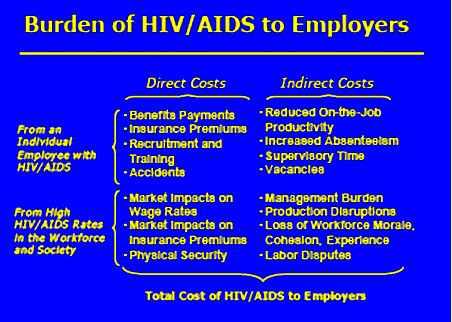ustralian AIDS Association *
A project by Ivanhoe Grammar School students Patrick Moio, Imogen Money, Thomas Gazis, Elizabeth Simcevski and Angeline Koutsoukos
*this is not a real organisation


Economic Impacts of the HIV/AIDS Pandemic
One way in which HIV and AIDS affects the economy is by reducing the labour supply through increased mortality and illness. Amongst those who are able to work, productivity is likely to decline as a result of HIV-related illness. Government income also declines, as tax revenues fall and governments are pressured to increase their spending to deal with the expanding HIV epidemic. With fewer people able to work, labour becomes more expensive and reduces investors profits. Thus, AIDS limits the ability of African countries to attract industries that depend on low-cost labour.



The sector with the worst economic consequences due to HIV is mining, followed closely by transportation and storage. About 27 percent of mine workers and 22 percent of transport and storage workers died from AIDS in Africa as of 2005. The diversion of funds meant for savings to pay for the costs of the illness has decreased investment potential and economic growth. All of these impacts have resulted in changes to the broader economies of Southern and Eastern Africa as a direct result of the high prevalence rates in these countries.
The impact that HIV and AIDS has had on the economies of the world is difficult to measure, especially in African countries. The economies of the worst affected countries were already struggling with development challenges, debt and declining trade before the epidemic started to affect the continent. HIV and AIDS has combined with these factors to further aggravate the situation. It is thought that the impact of HIV and AIDS on the gross domestic product (GDP) of the worst affected countries is a loss of around 1.5 percent per year; this means that after 25 years the economy would be 31 percent smaller than it would otherwise have been.